A Day in the Life: Niall
Ever wondered what it is actually like to study as a Foundation Year student at the University of Cambridge? Niall, a student at Queens' College, tells us more about a typical day on the course.
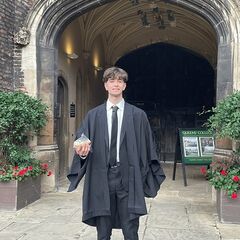
08:15: I typically aim to wake up at 8am, depending on whether or not I will need to attend a 9am supervision! On this day, I needed to, so I sprang out of bed and rushed to my gyp. A ‘gyp’ refers to a small kitchen typically found on accommodation landings or corridors. In my case, I share a gyp with the three other people on my floor. They are also (usually) characterised by their lack of ovens! The word ‘gyp’, intriguingly, was originally used to describe manservants of wealthy Cambridge students in days gone by. Thankfully, it no longer holds that meaning, but it illustrates the extent to which bizarre archaisms linger around in the University!
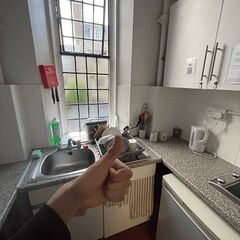
08:35: After wolfing down some breakfast, I streamed through my College, Queens’, to head to my morning supervision. While doing so, I relished in the mixture of old and new architecture in my College. Colleges vary in size and character. Some are ancient and traditional; some are modern and more relaxed. Queens’, I think, blends those two categories together. It does, on one hand, have all the characteristics of a medieval College: a Chapel, a Gothic dining hall and a towering Great Gate. However, equally, it boasts a large Brutalist court, Cripps, built in the 1970s. Though I am biased, I think it is also rather laid back and friendly.
Once I left College, I walked through the centre of Cambridge, before crossing the river Cam over one of the many Cambridges in the city. My walk to the West Hub, where most Foundation Year teaching is delivered, is incredibly scenic and pleasant. It was fairly chilly this morning, though, so I didn’t sightsee for too long!
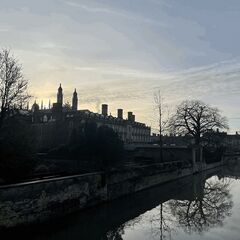
After entering the rustic peripheries of West Cambridge, I strolled into the West Hub. Constructed in 2020, the West Hub is a state-of-the-art, airy, and chic building with an abundance of neat features. Chief among them are its catering facilities: a cosy cafe, a kitchen (which serves fresh and affordable food), and even a small shop! After resisting the urge to buy a croissant, I entered one of the small meeting rooms upstairs to attend my supervision. Supervisions are one of the most distinctive aspects of the ‘Cambridge experience’. They are small-group teaching sessions that typically involve a discussion on a topic. Their informal nature gives you the opportunity to freely express and merge your ideas with your supervisors’ and other students’, making them one of the most important aspects of the learning experience in Cambridge.
10:00: After my supervision, I went to the library in the West Hub to complete some reading. Before long, though, I headed to my first lecture of the day. On the Foundation Year, lectures typically last for an hour. There are usually eight or nine of them per paper per term. They provide a concise, but informative, overview on a week’s topic. This lecture, titled ‘Material Culture and Power’, took an archaeological approach to analyse the various stages of King’s College Chapel’s construction, the materials used to construct it, and how those materials relate to royal patronage and power. This lecture, of course, was but one part of a wider paper titled “‘Something Magical, Something Sublime’: an interdisciplinary approach to King’s College Chapel”. The paper perfectly illustrates the stark focus on interdisciplinarity among the diverse range of papers offered on the Foundation Year. It draws upon the disciplines of art history, theology, history, and archaeology (to name but a few) to analyse King’s College Chapel’s multifaceted history and significance.
12:00: When the lecture ended, there was no time for dawdling. We headed straight to King’s College Chapel for a site-based seminar! We learnt about the history and symbolism of the Chapel’s iconic 16th century stained glass. Afterwards, we entered the Chapel to observe and reflect on the glass in-person! One of the most rewarding aspects of the Foundation Year is its emphasis on site-based learning. It enables us to consider the things we study as tangible and ‘living’, rather than as distant words or images on a page.
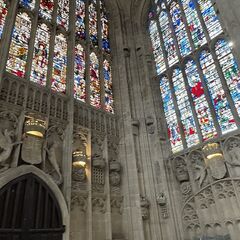
15:00: I had to reluctantly pull myself away from the Chapel, in all its splendour. I head back to Queens’ Library to complete some work. I completed my ‘Formative Assessment’, a short (1,000–1200 word) essay on the iconographic significance of the various hawthorn bushes in the Kings College Chapel’s stained glass! Students complete a 'formative' assessment in each of the papers they choose to take in a given term. They don’t contribute to our final grade. So, they provide an excellent opportunity to receive feedback on our skills and understanding mid-way through the term.
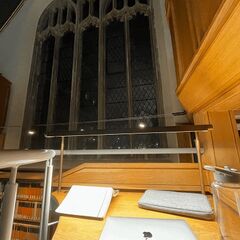
19:00: Stomach rumbling, I donned my suit and gown to attend the Foundation Year Halfway Hall, which was held in Queens’ marvellous medieval Old Hall. A quintessential aspect of Cambridge life, formal hall is a fancy candle-lit three-course meal. Though frequency differs from college to college, regular formal halls are typically held three or four times a week. They aren’t compulsory, however. So, most of us only attend them on special occasions, such as a subject dinner or to celebrate a friend’s birthday.
On this occasion, we were marking the half-way point of the academic year. It brought together current FY students, former FY students and some teaching staff. It was organised by FYSoc (a society dedicated to fostering inter-FY cohort socialisation and collaboration) and was a testament to the close-knit community that exists among all those connected to the Foundation Year. It’s a night I won’t forget in a hurry!
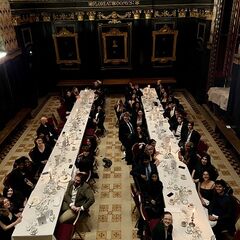
21:30: Having made a few new friends (and tempered my stomach’s earlier tremors), I trotted off back to my room with glee. I read for a while, then headed to bed. What a day indeed!
